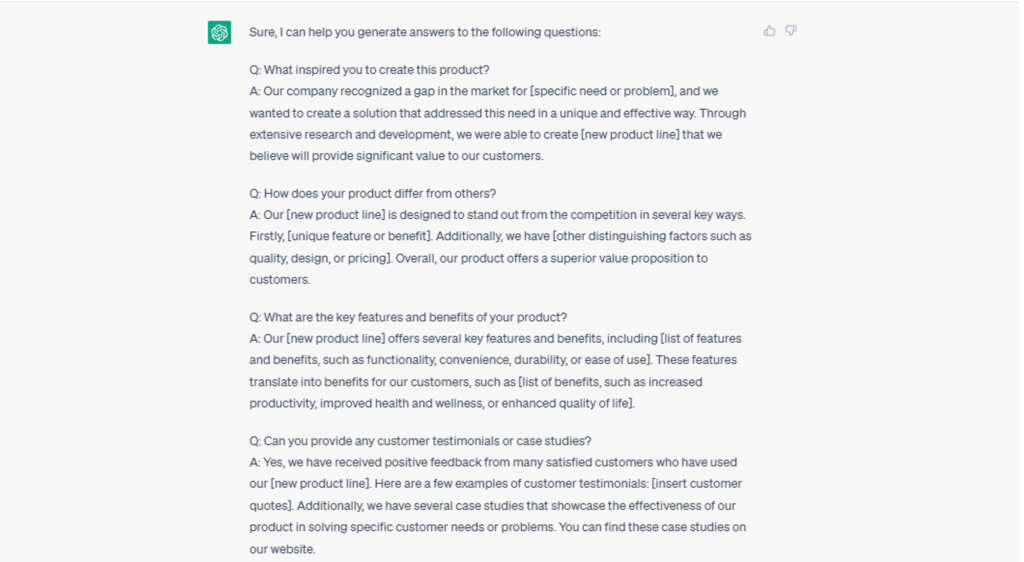
How To Create FAQ Content With ChatGPT

Creating an FAQ (Frequently Asked Questions) page is a great way to provide valuable information to your website visitors and address common queries. With the help of ChatGPT, an advanced language model, you can streamline the process of creating engaging and informative FAQ content. In this guide, we will explore step-by-step how to create compelling FAQ content using ChatGPT.
Understanding the Power of FAQ Content
FAQs act as a connection point between businesses and their audience, providing swift solutions to everyday issues. In this era of conversational AI, such as ChatGPT, incorporating FAQs becomes an engaging method to interact with users. If executed effectively, FAQ pages can notably influence a website’s standing in search engine rankings.
Researching Relevant Keywords
To ensure your FAQ content ranks high on search engine results, meticulous keyword research is crucial. Identify the key terms and phrases your target audience is likely to use when seeking information related to your product or service. Boldly incorporate these keywords into your FAQ content, ensuring a natural and seamless integration that enhances both readability and SEO.
Steps For Creating FAQ Content
Step 1: Identify Common Questions
The first step in creating an effective FAQ page is to identify the most frequently asked questions related to your product, service, or industry. Analyze customer inquiries, conduct market research, and review customer feedback to gather a comprehensive list of common questions.
By discerning and addressing these common questions, businesses can create an FAQ section that resonates with their customers, offering valuable information and alleviating concerns.
Step 2: Prepare the Data
Before using ChatGPT, you need to prepare the data for training. Compile the list of common questions and their corresponding answers. Ensure that the answers are concise, accurate, and provide relevant information. Organize the data in a structured format, such as a CSV file, with the questions in one column and the answers in another.
By meticulously preparing the data, the FAQ section becomes a valuable resource that not only addresses customer queries comprehensively but also reinforces the credibility of the business.
Step 3: Train the Model
With the prepared data, you can now train the ChatGPT model. Open the OpenAI API and use the provided endpoints to train the model on your FAQ dataset. This training process allows the model to understand the patterns and context of the questions and answers, enabling it to generate accurate responses.
Step 4: Generate Responses
Once the model is trained, you can start generating responses for new questions. Use the model’s API endpoint to send new questions and receive responses. The model will analyze the input question and provide a suitable answer based on the patterns it has learned during training. It is important to note that the quality of the responses may vary, and it is recommended to review and refine the generated answers before publishing them.
Utilizing ChatGPT or similar tools can be beneficial in refining and enhancing the responses, helping to maintain relevancy and accuracy. By investing time in crafting thoughtful responses, businesses can establish a resourceful FAQ section that not only addresses customer queries effectively.
Step 5: Customize and Fine-tune
ChatGPT allows you to customize and fine-tune the generated responses to match your brand voice and style. You can add specific instructions or prompts to guide the model’s responses. Experiment with different inputs and evaluate the outputs to ensure the generated content aligns with your desired tone and messaging. Fine-tuning also entails revisiting the section periodically to ensure its ongoing relevance and effectiveness. This dynamic approach allows businesses to adapt the FAQ content based on evolving customer needs and industry changes.
Step 6: Organize and Format
Once you have generated and customized the responses, organize them in a logical and user-friendly format. Group similar questions together and use headings or subheadings to categorize different topics. Consider using bullet points or numbered lists to make the content easier to read and navigate.
Step 7: Review and Update
Regularly review and update your FAQ content to ensure its accuracy and relevance. As your business evolves and new questions arise, it is important to keep your FAQ page up to date. Monitor customer feedback, analyze website analytics, and stay informed about industry trends to identify new questions that need to be addressed.
Step 8: Test and Optimize
Test the effectiveness of your FAQ content by gathering feedback from users. Encourage visitors to provide input on the clarity and usefulness of the information provided. Analyze user behavior on your website to identify any areas where users may be struggling to find answers. Use this feedback to optimize your FAQ page and make it more user-friendly.
Prompts For Creating FAQ Content
Prompt 1
“Hi ChatGPT! Could you assist me in creating an FAQ section for my [business], addressing frequently asked questions and reducing support tickets? Please provide answers to the following questions: What are your hours of operation? How can I place an order on your website? What’s your return policy? How can I track my order? How can I contact your customer support?”
Prompt 2
“Hi ChatGPT! We’re interested in creating an FAQ section for our [new product line]. Could you generate answers to the following questions? What distinguishes your product from others? What are the features and benefits of your product? How do I use your product? What is the warranty or return policy for your product? Can you provide any customer testimonials or case studies? Is there a way to get a discount on my purchase?”
Prompt 3
“Hi ChatGPT! I’d like to create an FAQ section for our [company’s employee handbook]. Could you provide answers to the following questions? What is your sick leave policy? How can I request time off? What are the expectations for employee conduct? What is the process for submitting expenses? How frequently are performance reviews conducted?”
Prompt 4
“Hi ChatGPT! We’re seeking to enhance our existing [FAQ section] by adding new questions and updating previous answers. Could you suggest responses to the following questions? How can I reset my password? What payment methods do you accept? Can I change my subscription plan? Do you offer international shipping? How can I cancel my subscription?”
Prompt 5
“Hi ChatGPT! We’re launching a [new product line] and wish to establish an FAQ section that addresses customer inquiries. Could you generate answers to the following questions? What inspired you to create this product? How does your product differ from others? What are the key features and benefits of your product? Can you provide any customer testimonials or case studies? How can I purchase your product?”
Results


Read Also: Write Product Description By AI.
Tips For Creating FAQs Content
Final Words
Creating FAQ content with the help of ChatGPT can save you time and effort while providing valuable information to your audience. By following these steps, you can create engaging and informative FAQ pages that address common questions and enhance the user experience on your website. Remember to regularly review and update your FAQ content to ensure its accuracy and relevance. With ChatGPT, you can streamline the process of creating and maintaining a comprehensive FAQ page.
For more such prompts you can come into our array of prompts to enhance your work.








